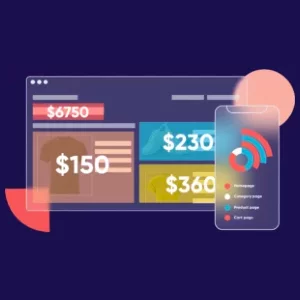
Find & Fix Product Demo
Watch our 6-minute product demo to learn how Contentsquare’s Find & Fix offer can help your business.

In order to rid your website, app or mobile site of friction points, you must first identify them, what’s causing them and where they’re most likely to hurt the experience. Only after you’ve determined this information can you undo the obstacles and up your users’ digital happiness. Customer journey analytics serves as the essential tool to understand how your visitors are navigating your site, revealing where friction points exist for your users.
Friction in user experience (UX) is defined as the instance or instances in which a visitor experiences difficulty with your website. The chief concept behind friction is the blockage of users from smoothly and painlessly completing an action. As such, points of friction are one of the main challenges in UX, as they preempt a seamless, intuitive journey. Sometimes they prevent a user from taking an action entirely. Friction can be described in general terms, or general problems within your site, while points of friction point to specific burdensome spots. It’s almost as if you’re doing a spot treat cleanse on your UX.
Friction: A Wide-Reaching Hindrance Customer Journey Analytics Can Tackle
Examples:
Customer journey analytics can be used to detect these hurdles so you can make targeted, data-backed optimizations. Even some of the broader concepts behind friction points — such as hesitation — can be measured with customer journey analytics. For example, you can measure how long it takes a customer to complete an online purchase, or how often customers abandon their shopping cart halfway through. By understanding how customers interact with your website and what obstacles they face, you can make adjustments to your digital experience to reduce friction and increase conversions.
Find & Fix Product Demo Watch our 6-minute product demo to learn how Contentsquare’s Find & Fix offer can help your business.
Customer journeys will vary from user to user, but there are certain universal UX features that can fall prey to malfunction. Some of these are not readily apparent and will require trial and error, with your users running into points of friction when using these elements. It’s good to know where these points typically occur, so that you can zero in on them when perusing through the customer journey analytics. Here are a few places in which friction points can live on your website that you may have not known about.

It’s easy to conjecture that you should look at the user flow, aka the site path, to detect friction. After all, this shows you which pages your customers had visited and where they’re exiting. But as far as friction point is concerned, a birds-eye view, which is essentially what you get when viewing the user flow, is too general.
However, it’s still an important first step. After you’ve viewed a visitor’s user flow, you should move onto a deeper read of how the user was interacting with your site within their journey, which brings us to the engagement rate.
As its name suggests, it shows you how well a page element is being engaged with, or — the percentage of visitors who clicked on an element after hovering it. Among other things, it relays how intuitive an in-page element is, i.e. its capacity to drive interaction.
This metric can detect the friction point associated with a clickable element that appears unclickable. For example, if a CTA, i.e., a clickable element, has a low engagement rate, it isn’t doing its job. Conversely, if a non-clickable element has a high engagement rate, it too is a point of friction, as it shouldn’t generate any clicks, a waste of time for users that ultimately leads them to frustration.
Another metric that will shed light on the experience the hesitation time, which, as its name points out, reveals the friction point of hesitation. It shows if your content is easily understood, as it measures the average elapsed time between the last hover and the first click on an element. A hefty hesitation time shows that visitors hesitate before they click on what they need, a source of great annoyance, especially if they are short on time.
Then, you should look to the click recurrence, which, like the engagement rate, can point to issues with identifying clickable and non-clickable elements. This metric unveils the average number of times an element was clicked when engaged with during a page view and can discern frustration, another common conversion deterrent. A high or low click recurrence can be either good or bad, depending on the context. For example, a carousel with a high click rate shows no point of friction, but good engagement, while a banner with a high click rate is negative in that it demonstrates users expect to land somewhere after clicking on it, but stay on the same page. Also, high click recurrence in form fields is bad news, showing that users are trying to fill in a field that is not allowing them to, thus causing friction.
Find & Fix Product Demo Watch our 6-minute product demo to learn how Contentsquare’s Find & Fix offer can help your business.
As a healthy conversion rate is established when users have a positive UX, a poor one usually paints a picture of friction points. There are several metrics that relate to the conversion rate, or take it into account. For example, conversion rate per hover is a metric that helps you decide if hovering over an area impacts a visitor’s behavior and conversion goal.
It is the number of users who achieved a behavior & hovered over a zone divided by the number of users who hovered the zone. Hovering over an area may not always lead to conversions and this shows you whether the hover was positive or a point of friction.
Take the product details. Does hovering over them lead to a high conversion rate? If not, perhaps there’s friction with understanding the copy, or the imagery of the product is not sufficient for the users to make a purchase or if they’re on a category page, to visit the product page.

Customer journey analytics are a practical way to inspect friction points for your site visitors. Every step in the user journey, from landing, to signing up, to searching, has the ability to either create or remove friction points. This friction can wreak havoc on your marketing efforts, firstly where acquisition is concerned. If you’ve successfully drawn visitors to your website, the last thing you want is for them to have a poor UX, which leads to exits, bounces and possibly, permanent abandonment.
That’s why a seamless, friction-free UX is standard in the current omnichannel environment users visit and brands rely on. The metrics in this post give you a snapshot of how customer journey analytics can be used to find friction points. But there are far more metrics and capabilities (think AI Alerts) that can be used to identify friction points. The more measuring tools you have to pin down these points of friction, the more adept you will be at keeping them at bay.
By understanding user behavior and the points where they experience friction, you can make data-driven decisions on how to improve your customer journey. This will help you optimize the user experience, build customer loyalty, and increase your bottom line.
Find & Fix Product Demo Watch our 6-minute product demo to learn how Contentsquare’s Find & Fix offer can help your business.